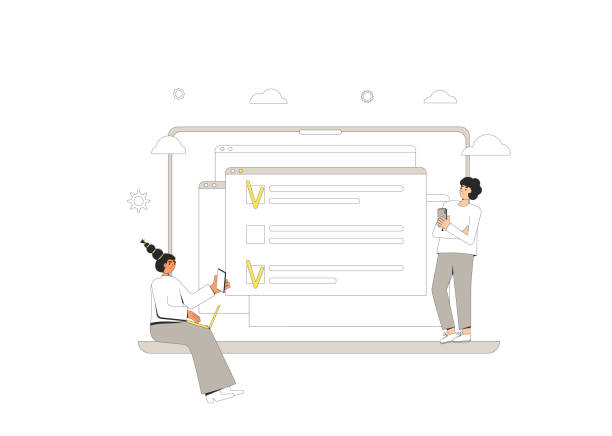An Introduction to Secure Website Design and Its Importance

In today’s digital world, where online interactions have become an indispensable part of our daily lives, #cybersecurity and particularly #secure_website_design are of vital importance.
Without a secure website design, businesses and users are exposed to countless threats that can lead to the loss of sensitive information, identity theft, damage to reputation, and significant financial losses.
This issue is not merely a technical challenge, but a strategic imperative for every online entity.
Building a secure website means protecting user data, financial transactions, and confidential business information against cyberattacks.
This involves a set of preventive measures, secure coding, proper server configuration, and continuous training for the development team.
The main goal of this educational article is to provide a comprehensive and specialized perspective on how to achieve website security in the design and development process.
Imagine you’ve launched a website that’s supposed to offer financial services; if this website isn’t designed from the outset with the principles of cybersecurity in mind, it can easily become the target of phishing or SQL injection attacks.
Therefore, a proactive approach in web security design is crucial.
This approach is not limited to preventing intrusion; it also includes preparedness for dealing with potential attacks and rapidly recovering the system after an incident.
In fact, investing in secure website design is not an additional cost, but rather a form of investment for the long-term sustainability and success of any online platform.
In this article, we will explain and analyze how a website with a security-first approach can be launched from its very initial stages.
This step-by-step guide will help you understand the concept and importance of secure website design and learn practical steps for its implementation.
This is a shared responsibility among developers, system administrators, and even end-users.
Did you know that 85% of customers check your company’s website before any interaction?
With RasawWeb, build a corporate website that truly reflects your credibility.
✅ Increase credibility and customer trust
✅ Attract high-quality leads
⚡ Get a free website design consultation
Common Website Security Threats

Before delving into secure website design, a precise understanding of common threats targeting websites is essential.
This knowledge helps us adopt appropriate defensive approaches in the process of building a secure website.
One of the most common attacks is SQL Injection, where attackers inject malicious SQL code into website input fields to access or manipulate the database.
This attack can lead to the theft, alteration, or deletion of sensitive information.
Another threat is XSS (Cross-Site Scripting), which allows an attacker to inject malicious scripts into web pages visible to other users.
These scripts can steal user cookie information, perform session hijacking, or even redirect users to malicious websites.
DDoS (Distributed Denial of Service) attacks are also serious threats that make websites unavailable and disrupt their performance by sending an overwhelming amount of traffic to the server.
Weaknesses in Session Management and Authentication can also open the door for attackers; for instance, using weak passwords or failing to implement two-factor authentication (2FA).
Furthermore, incorrect server and application configurations, outdated software and libraries (Vulnerable Components), and lack of user input validation are common weaknesses that attackers exploit.
Even brute-force attacks to guess passwords, or phishing that redirects users to fake pages, are examples of human threats that, alongside technical threats, challenge website security.
Awareness of these threats is fundamental for formulating a web security design strategy and its proper execution in every secure website design project.
This deep understanding helps development teams not only respond to known attacks but also be resilient against emerging threats and build stronger systems for secure website design.
Fundamental Principles of Secure Website Design from an Architectural Perspective

Secure website design begins from the very initial stages of system architecture and is not limited to just coding.
A secure architecture is the foundation of a robust website against attacks.
One of the fundamental principles in this regard is the Principle of Least Privilege; meaning that every user, process, or system should only have access to the minimum resources and permissions required to perform its function.
This approach prevents the spread of damage to other parts of the system in case of a breach in one section.
Another principle is Defense in Depth, which means using multiple layers of security.
Instead of relying on a single firewall or intrusion detection system, a combination of security controls should be used across different layers (network, server, application, database).
These layers include firewalls, data encryption, Intrusion Detection Systems (IDS) and Intrusion Prevention Systems (IPS), strong access controls, and database-level security.
Also, Separation of Concerns and Data is a key principle in secure website design.
For example, sensitive user information should be stored in separate sections with limited access levels.
The use of distributed and microservices architectures can also help increase website security, as a breach in a small service does not necessarily mean a breach of the entire system.
Designing for Fail Securely means that in case of any issue or error, the system should transition to a state that minimizes security damage; for instance, instead of displaying detailed error messages that could provide valuable information to an attacker, a general and secure error message should be shown.
Data encryption, both in transit (using SSL/TLS) and at rest (in the database), are other pillars of web security design.
Paying attention to these principles in the early stages significantly reduces the costs of subsequent reconstruction and modifications and ensures the sustainability of secure website design.
This is a comprehensive approach that considers security as an integral part of the entire website development lifecycle.
Essential Security Standards and Protocols

To ensure secure and reliable website design, adherence to specific security standards and protocols is essential.
One of the most important protocols is HTTPS, which uses the SSL/TLS protocol to encrypt communication between the user’s browser and the website server.
This prevents eavesdropping, tampering, or forgery of information during transmission and is crucial for any website that exchanges sensitive information (such as login details, financial transactions, or contact forms).
SSL certificates are issued by Certificate Authorities (CAs) and verify the website’s legitimacy.
Another standard is PCI DSS (Payment Card Industry Data Security Standard), which is a set of security requirements for organizations that process, store, or transmit payment card information.
Compliance with this standard is mandatory for any e-commerce website that handles financial transactions, and non-compliance can lead to severe penalties and loss of customer trust.
OWASP Top 10 is not a global standard, but it is a very important guidance resource that lists the top 10 most critical web security vulnerabilities.
Developers and website security specialists must continuously review this list and ensure their websites are protected against these common threats.
This includes items such as Injections, Broken Authentication, Sensitive Data Exposure, and Security Misconfiguration.
Authentication and authorization protocols like OAuth 2.0 and OpenID Connect are also important for securely managing user access in distributed systems.
Proper implementation of these protocols is an integral part of web security design.
Using HTTP security headers such as Content Security Policy (CSP) and HTTP Strict Transport Security (HSTS) can also help enhance secure website design.
These headers instruct browsers on how to handle website content and communications to prevent attacks like XSS and Clickjacking.
Finally, continuous training and updating of the development team on the latest security standards and threats is the cornerstone of a sustainable and efficient secure website design.
Did you know that 94% of users’ first impressions of a business are related to its website design? With professional corporate website design by **RasawWeb**, turn this initial impression into an opportunity for growth.
✅ Attract more customers and increase sales
✅ Build credibility and trust in the audience’s eyes⚡ Get a free website design consultation!
The Role of Developers in Implementing Secure Website Design

The role of developers in secure website design is absolutely central.
Security should not be a separate section or a final phase in the Software Development Life Cycle (SDLC), but rather should be continuously considered from the very beginning and at every stage of coding and testing.
This concept is known as “Security by Design” or “Secure Development Lifecycle”.
Developers are responsible for properly validating user inputs to prevent injection attacks (such as SQL Injection and XSS).
This includes sanitizing and filtering all data received from the user.
The use of up-to-date and trusted security frameworks and libraries that have built-in security features (such as CSRF prevention) is highly recommended.
Proper encryption of sensitive information, both in transit and at rest, is another important responsibility of developers.
This includes using strong encryption algorithms and secure key management.
Furthermore, correct implementation of authentication and authorization mechanisms, including password hashing using strong functions like bcrypt or Argon2, and proper user session management to prevent session hijacking, are crucial.
Developers must adhere to the principle of least privilege and ensure their code only requires the minimum necessary access for correct functionality.
Additionally, secure error handling and logging are highly important; sensitive information should not be displayed to the user in error messages, and logs should be collected and maintained in a way that is useful for security analysis.
Continuous training for developers on the latest vulnerabilities, attack techniques, and best practices for website security, through training courses, conferences, and online resources (such as OWASP), is essential.
Using Static Application Security Testing (SAST) and Dynamic Application Security Testing (DAST) tools during the development process can help identify vulnerabilities early on.
In summary, a successful secure website design is the result of developers’ commitment to adhering to security principles in all aspects of their work and embedding security thinking into every line of code.
This proactive approach lays the foundation for a secure and sustainable website design.
Database Security and Sensitive Information Management

The database is the beating heart of any website, where sensitive user and business information is stored.
Therefore, database security is an integral and vital component of secure website design.
The first step in securing the database is its physical or logical separation from the web server.
This prevents an attacker from easily accessing the database if the web server is breached.
Using Database Firewalls to control inbound and outbound traffic to the database and prevent unauthorized access is crucial.
Furthermore, all sensitive data (such as bank card information, national IDs, medical information, and passwords) must be stored encrypted in the database.
Even if an attacker gains access to the database, they cannot use this information without the decryption key.
User access management to the database must adhere to the principle of least privilege; each user (including the web application user) should only have access to specific tables and columns required for their tasks, and no more.
Additionally, the use of Prepared Statements and ORMs (Object-Relational Mappers) when building SQL queries is essential to prevent SQL Injection attacks.
These methods ensure that user inputs are processed as data, not executable code.
Keeping the Database Management System (DBMS) up-to-date and applying Security Patches is also crucial for closing known security vulnerabilities.
Encrypting communications between the web application and the database using SSL/TLS also prevents eavesdropping on information during transit.
Regular and secure backups of the database, stored in safe and separate locations, provide an additional layer of defense for data recovery in case of a security incident or data loss.
Continuous monitoring of database logs to identify suspicious activities and early detection of intrusions is also of high importance.
Implementing these measures is the cornerstone of a secure website design that not only protects data but also earns user trust.
Disregarding website security at the database level can render all efforts for secure website design ineffective and lead to irreparable consequences.
Penetration Testing and Vulnerability Assessment
![]()
After implementing the principles of secure website design, the next and crucial step is to evaluate the effectiveness of these measures through Penetration Testing and Vulnerability Assessment.
Vulnerability assessment is a process in which security weaknesses and loopholes in a system or application are identified, while penetration testing is the simulation of a real cyberattack by a team of specialists (penetration testers or white-hat hackers) to practically identify and exploit vulnerabilities and measure the system’s resistance to attacks.
These processes are an essential part of secure website design and should not be performed only once, but should be repeated periodically and after any major change in the system.
In penetration testing, testers use the same tools and techniques that malicious hackers employ, but with the difference that their goal is to find vulnerabilities and report them to the development team for remediation.
These tests can include identifying SQL injections, XSS attacks, weaknesses in session management, authentication flaws, incorrect server configurations, and even social engineering.
The findings from penetration testing include a comprehensive report of vulnerabilities, their severity, and recommendations for their remediation.
This report helps the development team to work targetedly on security weaknesses and significantly enhance website security.
The use of automated Vulnerability Scanners can also be helpful in the early stages and for identifying known vulnerabilities, but it does not replace comprehensive manual penetration testing by specialists.
Manual penetration testing has the ability to identify more complex and logical vulnerabilities that automated tools cannot detect.
The importance of this stage in web security design is undeniable; it allows organizations to identify and fix vulnerabilities before real attackers discover and exploit them.
Thus, building a secure website becomes an iterative and continuous process in which security is continuously improved.
This analytical and practical approach is the key to successfully maintaining a secure website design in the long term.
Security Incident Response and Data Recovery

Even with the best secure website design and strongest preventive measures, no system is completely impenetrable.
Security incidents may occur, and preparedness for effective response and rapid data recovery after they happen is another vital part of website security.
Having a comprehensive Incident Response Plan is essential for every online organization.
This plan should outline precise steps for identification, containment, eradication, recovery, and post-incident analysis.
Rapid detection of intrusions through monitoring systems and security logs, is the first crucial step.
The sooner an intrusion is identified, the less potential damage will occur.
After identification, the containment step is important.
At this stage, the goal is to prevent the spread of the attack and reduce the scope of damage.
This could involve isolating infected systems from the network, disabling compromised user accounts, or blocking attacker IP addresses.
Following containment, the eradication phase begins, which involves completely removing the intrusion agent from the system; this may mean cleaning malicious files, restoring the system from secure backups, or applying security patches.
The recovery phase includes restoring systems and services to normal operation.
This part must be carried out carefully, based on valid and verified backup versions, to ensure no re-injection of malware.
At this stage, vital services should be prioritized for restoration.
Finally, Post-Incident Analysis is crucial for fully understanding how the incident occurred, identifying the root causes of vulnerability, and learning from it to prevent similar incidents in the future.
This information helps in the continuous improvement of web security design and strengthening secure website building in the future.
Notifying users affected by the incident, if necessary and in accordance with privacy laws, should also be done with accuracy and transparency to maintain their trust.
Overall, a strong incident response plan ensures that even if security issues arise, the business can quickly return to normal operations and bring secure website design to a higher level of resilience.
How much does losing business leads due to an unprofessional website cost you? Solve this problem forever with professional corporate website design by RasawWeb!
✅ Increase credibility and trust of potential customers
✅ Easier attraction of new business leads
⚡ Get a free consultation now!
Future Trends in Secure Website Design and Development

The world of cybersecurity is constantly evolving, and with the emergence of new technologies, security threats and solutions also change.
Secure website design in the future will face new trends that require continuous attention and readiness.
One of the most important future trends is the use of Artificial Intelligence (AI) and Machine Learning (ML) in security.
These technologies can be highly effective in detecting suspicious and anomalous patterns indicative of cyberattacks.
AI-powered SIEM (Security Information and Event Management) systems will be able to analyze vast amounts of security logs and data to identify threats in real-time, which will significantly bolster website security.
Another trend is the increasing use of Serverless and Microservices architectures.
Although these architectures offer significant advantages in scalability and flexibility, they also present their own security challenges.
Web security design for these environments requires new approaches for identity and access management, container isolation, and API security.
API (Application Programming Interfaces) security will also gain increasing importance due to the growing interdependence of applications and third-party services.
Cyberattacks on APIs can open up avenues for penetration into the entire system; therefore, securing APIs with strong authentication, precise authorization, and input validation will be an integral part of secure website design.
Also, with the growth of the Internet of Things (IoT) and communication between various devices, websites must be prepared to manage and process secure data from these sources.
This necessitates attention to security at the device, network, and cloud levels.
Increasing user awareness and educating them is also an important future trend.
As phishing and social engineering attacks become more sophisticated, users play a crucial role on the front line of defense.
Overall, secure website design in the future will move towards smarter, more automated, and more flexible systems capable of adapting to emerging threats and continuously improving security.
This is a challenging but essential path for sustainability in the digital space.
The Importance of Education and Awareness in Website Security

Alongside all the technical and architectural measures mentioned for secure website design, the human factor and the level of education and awareness are of vital importance.
No security system, however advanced, can be completely resistant to human error or the unawareness of users and personnel.
Therefore, educating and raising the awareness level of all stakeholders, from developers to administrators and end-users, is one of the most effective ways to strengthen website security.
For developers, continuous training on the latest vulnerabilities (such as OWASP Top 10), best Secure Coding Practices, and correct use of security frameworks and libraries is essential.
These trainings must be practical and up-to-date so that developers can practically implement the principles of web security design.
System administrators and DevOps specialists must also be familiar with security topics related to server configuration, network management, the use of firewalls and intrusion detection systems, and how to manage security patches.
They are responsible for infrastructure stability and ensuring timely application of security updates.
Finally, educating end-users is also very important.
Many successful cyberattacks, such as phishing and social engineering, target users.
Educating users on how to identify suspicious emails and links, the importance of using strong and unique passwords, enabling two-factor authentication (2FA), and being vigilant against requests for personal information can significantly reduce the risk of attacks.
Regular awareness campaigns, workshops, and the dissemination of simple and understandable guidelines can help institutionalize a culture of secure website design within an organization.
An organization with high security awareness can quickly identify threats and respond to them.
This investment in education will yield a very high return in reducing security incidents and maintaining website credibility.
In summary, secure website design is not just a technical issue, but a shared culture and responsibility that is strengthened through education and awareness, leading to the long-term sustainability of a secure website.
Frequently Asked Questions
| Question | Answer |
|---|---|
| 1. What does secure website design mean? | Secure website design means creating a website that is resistant to cyberattacks and protects user and server information. |
| 2. Why is security important in website design? | To prevent data breaches, protect user privacy, maintain user trust, and avoid financial and reputational losses. |
| 3. What are the most common web vulnerabilities? | SQL Injection, Cross-Site Scripting (XSS), Cross-Site Request Forgery (CSRF), Broken Authentication, and Security Misconfiguration. |
| 4. How can SQL Injection be prevented? | By using Prepared Statements / Parameterized Queries, ORMs, and Input Validation. |
| 5. What is the role of HTTPS and SSL/TLS in website security? | HTTPS encrypts the communication between the user’s browser and the server using the SSL/TLS protocol, preventing eavesdropping and data manipulation. |
| 6. What measures should be taken to prevent XSS attacks? | Input validation, Output Encoding to prevent malicious code execution, and using Content Security Policy (CSP). |
| 7. What does a strong password policy include? | Enforcing long passwords, a combination of uppercase and lowercase letters, numbers, and special characters, and preventing reuse. |
| 8. How does Two-Factor Authentication (2FA) help security? | Even if a user’s password is compromised, the attacker cannot log in without access to the second authentication factor (such as an SMS code or an app). |
| 9. What is a Web Application Firewall (WAF) and what is its use? | A WAF is a firewall that monitors and filters HTTP traffic between a web application and the Internet to prevent common web attacks like SQL Injection and XSS. |
| 10. Why is regular updating of software and libraries important? | Updates often include security patches to fix discovered vulnerabilities. Failure to update can expose the site to new attacks. |
And other services of RasawWeb advertising agency in the field of advertising
Advertising economical laptops in online business directories
How to optimize ads for notebook importers for local search
Ad writing techniques for imported used laptops
Importance of technical specifications in notebook ads in business directories
Advertising after-sales services in ads of laptop importers
And over hundreds of other services in the field of online advertising, advertising consulting, and organizational solutions
Online Advertising | Advertising Strategy | Advertorial
🚀 Are you looking to boost your business in the digital space? RasawWeb Afarin, with years of experience in digital marketing and corporate website design, is your comprehensive solution for online growth and success.
📍 Tehran, Mirdamad Street, next to Bank Markazi, Southern Kazeroon Alley, Ramin Alley, No. 6




